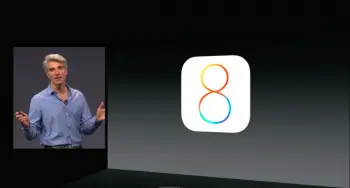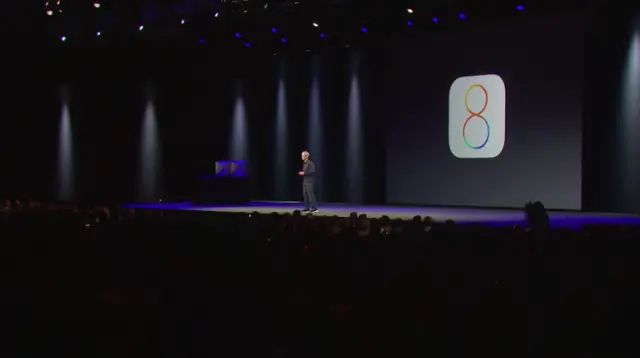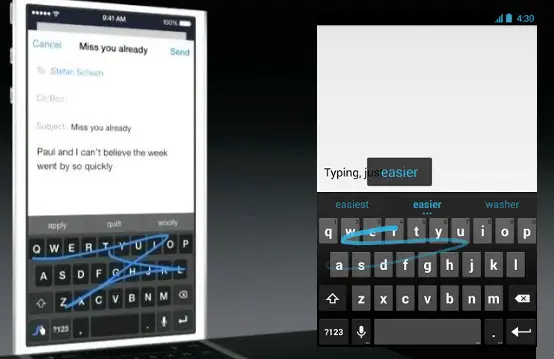
Top 6 ways iOS is becoming more like Android

For many an Android fanboy, we know enough about Apple’s shortcomings with iOS not to be swayed by the prospect of a few dozen more applications and games. For many years, we’ve watched as Apple — slowly but surely — began implementing many of Androids best features into iOS, repackaging them as their own.
This year’s WWDC 2014 was no different and those of you that watched the live stream of the event know that Apple was up to their same old tricks, reinventing many features we as Android users have been enjoying for years. We ain’t even mad. They made a good effort. Now, let’s take a look at best 6 “new” features in iOS 8, and see how they compare with their Android counterparts.
Keyboard with predictive text / 3rd party keyboard support

It’s probably the biggest pet-peeve many have had with iOS since its not so humble beginnings: lack of 3rd party keyboard support. Apple confined all its users to their keyboard, and their keyboard only. Why? Because they know best. To be fair, Apple’s keyboard is one of the better software keyboards and for iOS 8 and the inclusion of predictive text (ala Google Keyboard), makes it even better. But that’s only half the equation.
The other half is that after all these years, the new Tim Cook lead Apple is finally allowing 3rd party keyboards in the App Store. I know, it’s almost silly to watch as iOS fanboys everywhere lauded the new move, but when you’ve been in shackles for so long, it’s easy to get excited at the ray of sunshine peeking through the crack of a cell wall. While no 3rd party keyboard apps were specifically mentioned, we did see a mockup of Swype working on iOS 8 and we’re sure SwiftKey is already busy coding up something for iOS 8 as well.
Widgets
Just like we saw with 3rd party keyboards, we’re seeing another big with the slightly more “open” iOS this year. Addressing complaints since the dawn of iOS, Apple is finally introducing — wait for it — widgets in iOS 8… Well, sort of.
No, you can’t place them on the homescreen. Instead, developers can take advantage of new APIs that they can use to place widgets inside of Notification Center. They’re pretty functional too, showing information like sports scores or eBay auctions. But don’t expect to see the same robust widgets that we’ve enjoyed on Android all these years. As so often is the case, iOS’ implementation is much more simple.
Actionable notifications
Android’s notifications panel saw a major redesign back during Ice Cream Sandwich and it only got better in Jelly Bean. Apple, still being somewhat new to the concept of notifications (Notification Center debuted back in iOS 5), is now finally introducing new actionable notifications for iOS 8.
Soon, users will be able to interact with their notifications while inside another app, without having to jump inside another app to respond or address a notification. Sliding down a notification banner will display actionable items, giving users the ability to reply to SMS messages, address calendar events, or like a comment on Facebook. Once again, it’s not the same robustness we’ve seen on Android, but something is better than nothing.
Messages
For iOS 8, Apple is introducing a handful of new features that brings Messages closer to Hangouts than ever. First up, iOS users will soon be able to send their location to other friends and/or family, handy when you don’t feel like searching for or typing up an address. Also new is the ability to send short video or voice messages. Once again, useful when you’re hands aren’t free to type something out.
If you’ve been using Hangouts on iOS, you’d know that a few months ago they added the ability to send video messages (although it’s not available in the Android version yet). So we’ll hand it to Apple, they done did good. What’s more is messages can be set to self-destruct a la Snapchat and they also added new options for group messaging so users can finally leave group chats, or rename them.
Apple is also making it extremely easy to receive calls and messages from your phone on your OSX computer. Of course, you can do this right now using Hangouts and it works whether you’re using OSX or Windows. However, we will admit, Apple’s implementation is nice in that it works right out of the box with little-to-no setup.
Extensions (sharing)
The crowd went nuts when Apple announced the extensions for iOS 8. Essentially a way for apps to communicate with one another, it’s just another feature we’ve long enjoyed on Android for countless releases. Of course, Apple is using it a bit differently in that developers will first need to enable this feature in their apps. Once (if) they do, it will be possible to open up a picture in the Photos app, and share it to a photo editing app. We know, your minds are blown. The benefit Android has is that sharing is built into the core OS. In other words, “It just works.”
Always-listening Siri
It’s a killer feature found on the Motorola Moto X (and technically possible on any Snapdragon 800 device): the ability to send voice commands to your phone without ever touching it. Apple is adding this breakthrough new feature in Siri for iOS 8, allowing users to speak the command, “Hey Siri,” (much like “Okay Google Now”) and further direct the phone to perform searches, or queue up Shazam to identify a song.
*****
Before we leave, we just want to say we’re not trying to start a flame war. Although it can be fun to play devil’s advocate, we get it. At the end of the day, both mobile Android and iOS are great and serve their specific purpose. While we agree that it can be irritating to watch another company bite/copy/steal some of Android’s best ideas, it’s just the evolution of modern software and something that comes with the turf. Borrow one idea, improve it, and so forth.
We’ve felt for awhile now that mobile OS’ will soon match each other in terms of features, and at the end of the day, which platform you align yourself with is your prerogative. Still, when it comes to openness, customizations, and options — we still choose Android.
